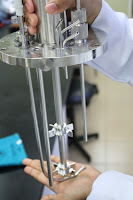For the third day which is also the last day, we did the two last sampling. The first sample was taken at 8.00 am and the last one was at 10.00 am. The sample was taken, and we measured the cell growth using spectrophotometer by determining the optical density (OD) reading. We did dilution for samples that have OD reading of more than 0.5.
| Duration | Time | OD | DF(OD) | OD×DF | Glu (mmol/L) | DF(Glu) | Glu (mg/dL) |
| 0 | 2pm | 0.137 | - | 0.137 | 24.6 | 4 | 1771.2 |
| 2 | 4pm | 0.454 | - | 0.454 | 24.6 | 4 | 1771.2 |
| 4 | 6pm | 0.381 | 3 | 1.143 | 19.9 | 4 | 1432.8 |
| 6 | 8pm | 0.352 | 5 | 1.760 | 15.0 | 5 | 1375.0 |
| 8 | 10pm | 0.262 | 7 | 1.834 | 18.3 | 2 | 660.2 |
| 18 | 8am (Fri) | 0.198 | 7 | 1.386 | 7.5 | 2 | 270.0 |
| 20 | 10am (Fri) | 0.468 | 5 | 2.340 | 4.7 | 1 | 85 |
Then we measured the concentration of glucose in the bioreactor by using glucose meter. The glucose utilization is measured as an indication that the cells are growing. As the cells grow, they will utilize the glucose, therefore the concentration of glucose that remained in the bioreactor should be reduced. The OD value increase until 6 hours of fermentation. This indicates that the cells are in log phase, where the cells are growing and utilizing glucose as a carbon source. Starting 6 hours until 8 hours of fermentation, the graph shows that the cells are in stationary phase. During this state, the toxin produced by the cells cause stress to them. Besides, there is no carbon coming into bioreactor. Therefore, oxygen cannot react with carbon to form carbon dioxide. Starting 8 hours to 18 hours of fermentation, the graph declines, showing that the cells are in death phase. The cells die because of no nutrient available.
During that day, Mr Sharman showed us a model of 10L bioreactor. He also explained the functions of the bioreactor and how it operates. Basically, there is no much difference between the 10L bioreactor with the one that we are using. After the explanation, there was a question and answer (Q and A) session regarding bioreactors. During the session, we asked him lots of questions that we have been curiously wanted to know.
As we finished with monitoring the cell growth through manual sampling and data logging, we stopped the fermentation and started the cleaning process! For the cleaning process, firstly, all the wires, power supply and probes are disconnected from the bioreactor. The vessel and the filters that have been removed and cleaned were taken to be autoclaved in the incubator at 70ᴼC for sterilization. All the equipments are returned and stored in the box.

There goes our 3 days LAB-athon, many things we learnt but we personally favour an important advice from Mr. Shaman that is once you identify a problem, solve it immediately. Mr. Shaman likes to mention this whenever there's problems arise from either any of the groups. He told us that if you let the problems unsolved, many will come on later. This doesn't just apply to our lab here but it also applies to our daily lives, whenever there're problems, face it immediately so that non will comes on later.





















